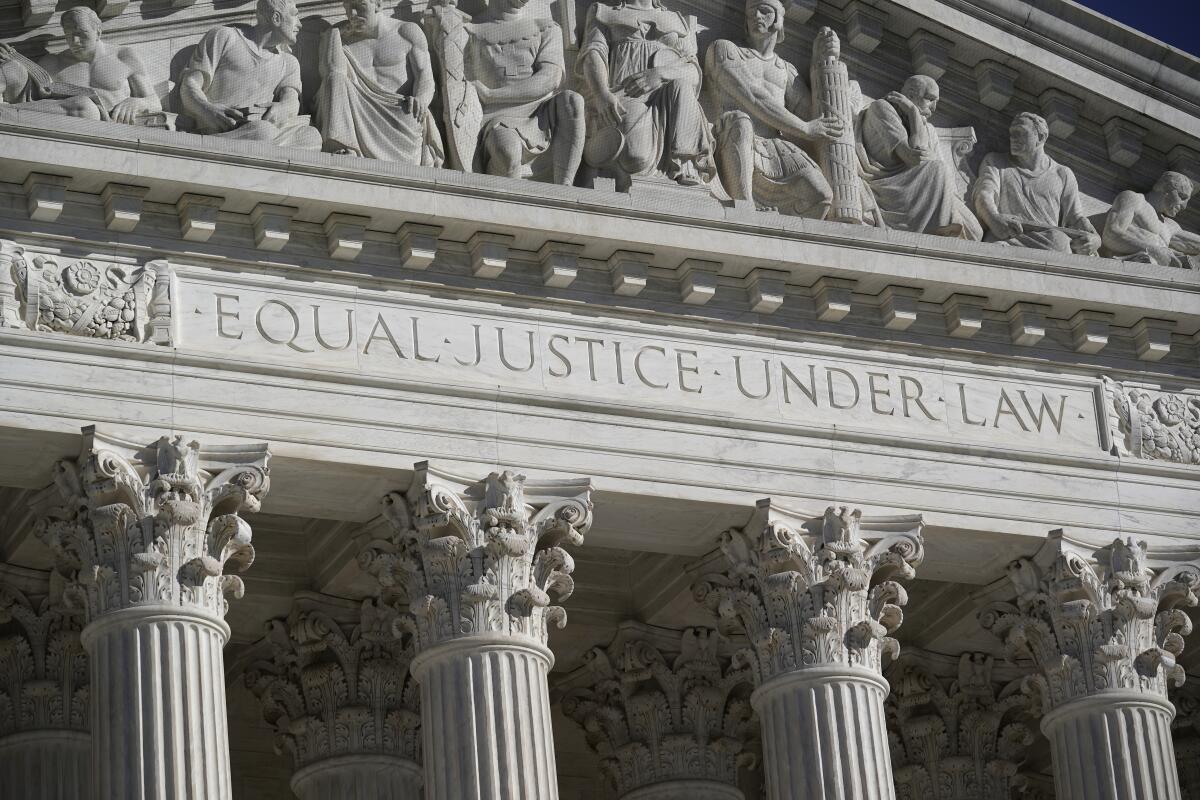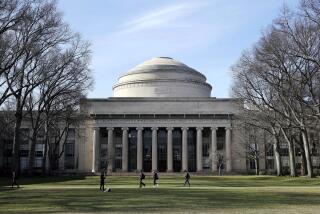Supreme Court signals it may outlaw most affirmative action at universities

- Share via
WASHINGTON — The Supreme Court agreed Monday to hear a major challenge to race-based affirmative action in the nation’s colleges and universities, setting the stage for another long-sought win for conservatives.
The justices voted to hear a pair of appeals contending that Harvard University, the nation’s oldest private university, and the University of North Carolina at Chapel Hill, the oldest public university, are violating civil rights laws by giving preferences to some minority students seeking admission while discriminating against others, including Asian Americans.
They ask the court to rule that universities, whether public or private, may “not use race as a factor in admissions.” And they rely on the Civil Rights Act of 1964, which says no person “shall be subjected to discrimination ... on the ground of race, color or national origin” in a school or university that receives federal funds.
Since 1978, however, the Supreme Court has held that colleges, universities and law schools may consider a student’s race or ethnicity as a “plus factor” in order to create more diversity in their classes. In recent decades, the court took up anti-affirmative action challenges to the admissions policies at the University of Michigan Law School and the University of Texas but upheld them narrowly over sharp dissents from the conservatives.
Chief Justice John G. Roberts Jr. was among the dissenters, and he now has five more conservative justices on his right. And they are in position to overturn the past rulings that upheld affirmative action.
The effect in California may be limited, however. In 1996, the state was the first to outlaw race-based admissions policies when the voters adopted Proposition 209. It said public universities such as the University of California may “not discriminate against or grant preferential treatment on the basis of race, sex, color, ethnicity, or national origin.” A move to repeal that measure failed in the November 2020 election. Eight other states have since adopted similar measures, including Washington, Michigan and Florida.
But a ruling striking down Harvard’s admissions policy would also apply to other private colleges and universities, such as Stanford and USC.
The pair of cases to be heard by the high court were created and managed by Edward Blum, a retired financier who has launched a series of lawsuits to challenge what he sees as an illegal use of race by colleges and universities. He enlists supporters to back his cases, and he created a group called Students for Fair Admissions to sue Harvard and UNC.
The group says it has 20,000 members, including Asian American students who were denied admission to Harvard. Its goal is to “restore the original principles of our nation’s civil rights movement. A student’s race and ethnicity should not be factors that either harm or help that student to gain admission to a competitive university.” Since UNC is a state university, it is also alleged to violate the 14th Amendment’s guarantee to the “equal protection” of the laws.
“It is our hope that the justices will end the use of race as an admissions factor at Harvard, UNC and all colleges and universities,” Blum said Monday. “Every college applicant should be judged as a unique individual, not as some representative of a racial or ethnic group.”
Sherrilyn Ifill, president of the NAACP Legal Defense Fund, said the court’s decision “seriously threatens the nation’s ideals of equality. Holistic, race-conscious admissions programs enable Harvard University, the University of North Carolina, and other colleges and universities to bring together people of different backgrounds to learn from one other. As our country experiences a resurgence of white supremacy, it is as important now as ever before that our future leaders be educated in a learning environment that exposes them to the rich diversity that our country has to offer.”
An Asian American civil rights group in San Francisco also urged the court to preserve affirmative action.
“Amid a national reckoning with anti-Asian racism, we know that discrimination is not a relic of the past and continues to pervade and distort the lived experiences for people of color in this country every day. We still need these programs,” Asian Americans Advancing Justice said in a statement. “Seventy percent of Asian Americans support affirmative action. We reject the use of Asian Americans as proxies to attack the constitutionality of race-conscious programs.”
Lower courts were unanimous in rejecting the lawsuits brought by Blum’s group. A federal judge in Boston, the 1st Circuit Court there and a federal judge in North Carolina all concluded the challengers had exaggerated the effect of race in the admissions process. They said the universities follow the Supreme Court’s past guidance by weighing a student’s race or ethnicity as one factor when choosing among a group of well-qualified applicants.
Harvard, for example, says it selects 1,600 freshmen each year from more than 35,000 highly qualified applicants.
“To assemble the strongest first-year class, Harvard looks for students who excel beyond academics and who will bring distinctive experiences, perspectives, talents, and interests to campus,” the university’s lawyers told the court. It “does not pursue racial quotas or balance” and “does not automatically award” preferences to Black or Latino applicants, they added.
In a statement Monday, Harvard President Larry Bacow said the court’s action “puts at risk 40 years of legal precedent granting colleges and universities the freedom and flexibility to create diverse campus communities. Harvard will continue to defend vigorously its admissions practices. ... Harvard does not discriminate; our practices are consistent with Supreme Court precedent; there is no persuasive, credible evidence warranting a different outcome.”
Harvard has played a special role in the history of affirmative action. In 1978, when the court took up its first challenge to affirmative action, it ruled for Allan Bakke, a rejected white applicant to the UC Davis Medical School who alleged he was a victim of racial discrimination. The court ruled the UC system had wrongly set aside a fixed number of slots for minority applicants.
But the Bakke decision is better remembered for a crucial passage written by Justice Lewis Powell. He cited approvingly the Harvard College admissions policy that “takes race into account in achieving educational diversity.” This approach “includes students from disadvantaged economic, racial and ethnic groups. Harvard College now recruits not only Californians or Louisianans, but also Blacks and Chicanos and other minority students,” he wrote.
In response, colleges and universities, including their law and medical schools, adopted the Harvard model of admissions based on the goal of “diversity.”
In their appeals, Blum’s lawyers argue that Harvard and UNC are not following Powell’s approach but instead are systematically ranking students based on their race and ethnicity.
They contend the universities regularly “penalize” Asian American applicants and require them to have far higher grades and test scores to win admission compared with Black and Latino students. “Jewish students were the first victims of holistic admissions, and Asian Americans are the main victims today,” they wrote in the UNC appeal.
They also contend both universities could achieve racial and ethnic diversity through “race-neutral alternatives,” such as giving preferences to disadvantaged students who come from families with a low-income or a community where few went to college.
The court will hear arguments this fall in the two cases, Students for Fair Admissions vs. Harvard College and Students for Fair Admissions vs. University of North Carolina. A decision would not be expected until 2023.
More to Read
Get the L.A. Times Politics newsletter
Deeply reported insights into legislation, politics and policy from Sacramento, Washington and beyond. In your inbox twice per week.
You may occasionally receive promotional content from the Los Angeles Times.








